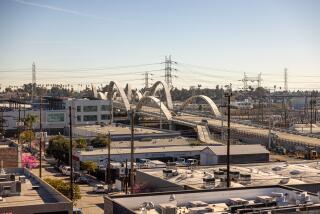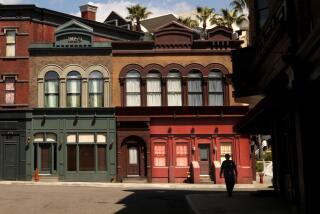As Wrecking Ball Looms, It’s So Long to Shanghai’s SoHo
- Share via
SHANGHAI, China — When painter Ding Yi moved his studio into a decaying warehouse along Suzhou Creek two years ago, he helped start something new in this busy business city--an artists’ community.
So many painters and sculptors followed that newspapers began calling the area Shanghai’s SoHo, after the artist-loft district in New York City. Soon, art galleries opened, attracting wealthy Chinese and foreign collectors.
But a bohemian enclave didn’t fit in the city’s redevelopment plans. The Suzhou Creek warehouses, which cover several blocks, are being torn down to make way for a city planner’s vision of modern urban utopia--a park and hundreds of families in rows of identical high-rise apartment buildings.
“It’s a shame because a community was really taking shape here. It’s going to be hard to just re-create it somewhere else,” said Ding, who has the artist look, with his long hair and black, round glasses.
The change comes as China’s largest city pushes forward with an ambitious urban face-lift aimed at turning itself into a major commercial center. But the demolition of the Suzhou Creek warehouses highlights concerns that development is too heavy-handed.
Since Shanghai’s building binge began in the early 1990s, more than 70,000 old buildings have been torn down every year, according to city figures.
Downtown, block after block of steeple-roofed tenement housing from China’s early 20th century industrial revolution has vanished--to be superseded by Space Age glass office towers.
City planners say hundreds of the most beautiful and historical buildings will be saved.
“But there has to be balance between preservation and development, and we are still a developing country,” said Huang Jiming, chief engineer at the city government’s Shanghai Urban Planning and Design Research Institute.
Redevelopment plans are laid out by city engineers such as Huang, sometimes years ahead. In the City Planning Exhibition Hall, residents crowd around a detailed model of the city in 2020 to see if their homes will still be standing.
Many of the new buildings are paid for by private investors. This marriage of central planning and the market has revitalized Shanghai after decades of neglect under communist founder and leader Mao Tse-tung, who punished the city for its pre-revolutionary success as Asia’s business capital.
But critics say Shanghai could suffer if not given freedom to grow spontaneously. They say old neighborhoods should be allowed to reinvent themselves and find new identities. Diverse neighborhoods and rich history are what make cities like New York cultural as well as commercial centers, they say.
“It will be too late when they realize these ruined communities were things of value that can never be rebuilt,” said Lu Yongyi, a professor of urban planning at Shanghai’s Tongji University.
Shanghai is still widely seen as the materialistic, shallow cousin of Beijing, the political capital. Beijing’s universities and art schools attract the rougher edges of Chinese culture--from punk rockers to deconstructionist thinkers.
It wasn’t always this way. As a European-ruled treaty port before World War II, Shanghai was a magnet for radicals including Mao and novelist Lu Xun.
A Shanghai cultural revival seemed possible during the 2000 Shanghai Biennale art exhibition, when riskier alternative shows at Suzhou Creek studios drew more praise than the official entries in the city’s art museum.
The Shanghai SoHo is now home to two major galleries and two dozen of the city’s best-known modern artists.
One of the first to move here was Ding, the painter. He chose an abandoned British-built cotton warehouse for its low rent and space--enough to create dozens of wall-size paintings.
He said artists were inspired by the old brick buildings, gritty streets and tooting of barge traffic on Suzhou Creek, which skirts the north edge of downtown Shanghai. They shared ideas and tried to create a Shanghai scene.
“This neighborhood was something that appeared spontaneously because the setting worked for the artists,” Ding said.
Gallery owners and artists talk about creating the same atmosphere elsewhere but admit it will be difficult to find a suitable neighborhood. They do not seem to be coordinating efforts to find new space, perhaps hoping an artists’ colony will crop up anew elsewhere with the same spontaneity.
Ding and others in the Suzhou Creek enclave said officials refused to speak to them about saving the warehouses.
“We’re too small. We’re like the ants you discover while cleaning your kitchen,” said Lorenz Helbling, a longtime Swiss resident of Shanghai who owns ShanghART, a Suzhou Creek gallery that will have to move.
“City planners just want to clear us out,” Helbling said. “But for us, this is home.”
More to Read
Sign up for Essential California
The most important California stories and recommendations in your inbox every morning.
You may occasionally receive promotional content from the Los Angeles Times.













